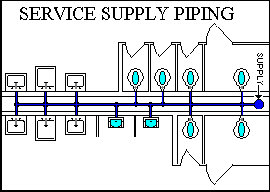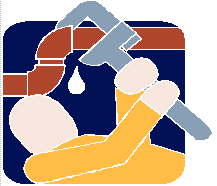COMPUTER SOFTWARE FOR THE PLUMBING DESIGNER©
by Bill Smith, president of Elite Software

 Compared to mechanical and electrical engineers, plumbing designers have been the forgotten stepchild when it comes to having software available. For many years, software has been available for the mechanical designer in the form of HVAC load calculation and duct sizing programs to name a couple. The electrical engineer has long had programs for short circuit and voltage drop analysis, but the poor plumbing engineer has had almost nothing. However, times have changed and capable software is now becoming available specifically for the plumbing designer.
Compared to mechanical and electrical engineers, plumbing designers have been the forgotten stepchild when it comes to having software available. For many years, software has been available for the mechanical designer in the form of HVAC load calculation and duct sizing programs to name a couple. The electrical engineer has long had programs for short circuit and voltage drop analysis, but the poor plumbing engineer has had almost nothing. However, times have changed and capable software is now becoming available specifically for the plumbing designer.
There are three primary areas where software can help the plumbing designer. The first is in the design of domestic hot and cold water service supply systems. The second is in the design of sanitary building drain systems, and the third is the actual drawing of the plumbing pipe networks. The first two applications, sizing the water supply and  drainage systems, require the use of computer programs designed especially for those applications. The third application, drawing the piping network, can be automated with any number of general purpose computer aided drafting (CAD) programs such as AutoCAD. This article will discuss various programs currently available for the plumbing designer.
drainage systems, require the use of computer programs designed especially for those applications. The third application, drawing the piping network, can be automated with any number of general purpose computer aided drafting (CAD) programs such as AutoCAD. This article will discuss various programs currently available for the plumbing designer.
At the recent American Society of Plumbing Engineers (ASPE) Show in Long Beach, California, two companies were exhibiting plumbing design software. These companies were Elite Software of Bryan, Texas, and the International Association of Plumbing and Mechanical Officials (IAPMO) in Walnut, California. A thorough search of engineering trade journals also revealed one other company that offers plumbing design software, Industrial Microsystems International (IMI) of South Laguna, California. Many engineering firms have also developed plumbing design software for in-house use, but those packages are not generally available to the public.
 Three IBM-PC compatible programs are available for sizing domestic hot and cold water piping systems. These are IMI Size by IMI, PIPE88 by IAPMO, and SPIPE by Elite Software. The basic input data of these programs is the pipe network layout, system type (flush valve or flush tank), the location, quantity and type for all fixtures (sinks, lavatories, etc.), and the sizing criteria (maximum allowable water velocity and pressure loss per 100 feet of pipe). The programs look up the fixture units associated with each fixture and then accumulate all fixture units that affect each pipe section. Once the total fixture units affecting each pipe is known, the programs then use the Hunter GPM Demand Curve to determine the probable gpm flow rate through each pipe section. With the gpm flow known for each pipe, the programs are finally able to select the optimum pipe size. With water supply systems, the optimal pipe size is the smallest size that does not cause too high of a water velocity or a pressure drop exceeding the maximum allowed.
Three IBM-PC compatible programs are available for sizing domestic hot and cold water piping systems. These are IMI Size by IMI, PIPE88 by IAPMO, and SPIPE by Elite Software. The basic input data of these programs is the pipe network layout, system type (flush valve or flush tank), the location, quantity and type for all fixtures (sinks, lavatories, etc.), and the sizing criteria (maximum allowable water velocity and pressure loss per 100 feet of pipe). The programs look up the fixture units associated with each fixture and then accumulate all fixture units that affect each pipe section. Once the total fixture units affecting each pipe is known, the programs then use the Hunter GPM Demand Curve to determine the probable gpm flow rate through each pipe section. With the gpm flow known for each pipe, the programs are finally able to select the optimum pipe size. With water supply systems, the optimal pipe size is the smallest size that does not cause too high of a water velocity or a pressure drop exceeding the maximum allowed.
Beyond performing basic pipe sizing most of the programs also list individual pipe pressure losses, flow rates, and water velocity, total system pressure drop, and the pressure required from the main to operate the system. Two of the programs, IMI Size and SPIPE, also show a bill of materials with cost estimates. Perhaps, the greatest benefit provided by these programs is that the project data is stored on floppy disk so that it is easy to analyze different pipe layout alternatives. The ability to quickly evaluate design alternatives provides for much more optimal plumbing pipe systems.
For sanitary drain and vent sizing, there are two IBM-PC compatible programs available. These are DRAIN88 by IAPMO and DPIPE by Elite Software. The input data required for these programs is very similar to the data required for the water supply piping programs. The primary difference is that the programs must know whether a pipe is a branch, stack, sewer, branch vent, or stack vent. Rather than look up standard fixture units, these programs must look up drainage fixture units for each fixture. Pipe sizing for drainage systems is much simpler than for supply systems. Once the total drainage fixture units is known for each pipe, the programs automatically consult sizing tables to determine the optimal size for each pipe. The DPIPE program references sizing tables by BOCA while DRAIN88 follows the Uniform Plumbing Code tables. The main advantage of using a drainage pipe sizing programs is speed and accuracy.
Although the basic functions of the design programs mentioned are very similar, there are actually many differences in how the programs work. This is especially true concerning input procedures, built-in help capabilities, documentation support, report capabilities, pipe material libraries, plumbing fixtures, and provision for fittings. It is suggested that the plumbing designer contact the companies involved to obtain detailed literature. Note also that Elite Software and IMI offer demonstration disks of their software for those who want to further evaluate their programs.
Regarding computer aided drafting (CAD) of plumbing systems, there are two types of software needed. First, a basic CAD package must be selected. Second, it is virtually a necessity to purchase accessory CAD software that helps the basic CAD package draw plumbing pipe systems. General CAD software is geared towards the basic drawing of lines, arcs, circles, and rectangles. When you want to draw specific things like valves and fittings, it is very tedious to draw them using basic lines and arcs. You need software that automatically draws things common to your application. For plumbing design, that would be pipes (single line and double line), valves, fittings, fixtures, and special items like water heaters, dishwashers, and other such equipment. This CAD accessory software must be used in conjunction with a basic CAD package, and it is commonly referred to as a "drawing aid". Drawing aid software is sometimes, but not always, accompanied with plastic template overlays for use on a digitizing tablet.

The selection of a basic CAD package for creating plumbing drawings is a subject unto itself. There are many great CAD packages available, and each has its own special advantages. Some of the more popular CAD packages include AutoCAD from Autodesk Inc., VersaCAD by VersaCAD Corp, CADVANCE by Isicad Inc., and CADKey by CadKey a division of Micro Control Systems. However, it is very safe to say that AutoCAD is by far and away the most popular with mechanical and plumbing designers. The main reason for AutoCAD's popularity with plumbing designers is that there is more drawing aid software specifically for piping applications using AutoCAD than for any other basic CAD package.
Just as there are many basic CAD packages so are there many drawing aid packages. Plumbing design is often considered a subset of the mechanical design of a building. Therefore many drawing aids promoted as mechanical drawing aids actually include provisions for quickly drawing plumbing pipe systems. Mechanical drawing aids usually include provisions for HVAC, chilled water piping, and plumbing piping. Three such drawing aids are the AEC Mechanical Template System by Autodesk, the CaddLINK Mechanical Drawing System by CaddLINK Inc., and the CadPLUS Mechanical Drawing System by CadPLUS Products Company.
In addition to mechanical drawing systems, there are also a number of specific pipe drawing systems. These pipe drawing systems can be used for plumbing pipe drawings, but their main purpose is usually for process piping in plants. The problem with using the specific pipe drawing systems for plumbing drawings is that they are expensive and have many more features than are necessary for the average plumbing drawing. Still, some of their features like isometric views are quite appealing, and some plumbing designers can possibly justify the use of specific pipe drawing systems. Three very good specific pipe drawing systems are WELDPIPE by Chase Systems, PRO-PIPE by Applications Development Inc., and CADPIPE by Endeco Engineering Ltd. in Canada.
Many engineering firms are already very sophisticated in the use of CAD, so much so that they have developed their own drawing aids. Such experienced CAD users can benefit from another type of CAD accessory product called a symbol library. A symbol library is a collection of predrawn symbols and icons of commonly used items. All of the mechanical and piping drawing systems mentioned previously actually include a symbol library as part of their complete package. However, the firm that has already created its own drawing system usually does not want to replace it with a new one. The solution for such firms is to purchase a symbols library that can be integrated into their existing drawing system. Symbol libraries are more common than complete drawing aid systems and a lot less expensive. Companies providing low cost pipe symbol libraries include KETIV Technologies of Portland, Oregon, Drafting Technology Services of Bartlesville, Oklahoma, and Compugraph X of Westminster, California. A typical pipe symbols library costs from $75 to $150 while a complete pipe drawing system aid costs from $700 to $5,000. Since symbol libraries and drawing system aids are all add-ons to a base CAD package, the cost of a complete CAD system for plumbing design is somewhat expensive and quite variable.
Given all the possible alternatives for creating plumbing drawings with a CAD system, what is the most common type of system used by plumbing designers? Without a doubt, the most common type of CAD system used by plumbing designers is an IBM compatible computer equipped with AutoCAD and a good mechanical drawing system aid. There are actually many common variations found on such a system, but the basic system as described is a good starting place for any plumbing designer looking towards using a CAD system.
Although the number of programs for specific plumbing design is somewhat limited, if you count all the CAD and drawing aid packages available, then there is actually quite a bit available. As plumbing designers begin to embrace the computer more, there will certainly be more plumbing design programs offered. If this trend continues, plumbing designers can expect to see software for such design tasks as medical gas systems, storm water drainage, and compressed air piping. Although lagging many years behind HVAC and electrical developments, plumbing design software is finally here. All that's required is for plumbing engineers to get with the program!
 Mr. Smith welcomes your email about this article. - email
Mr. Smith welcomes your email about this article. - email
Copyright ©
Elite Software Development, Inc., webmaster@elitesoft.com
 Compared to mechanical and electrical engineers, plumbing designers have been the forgotten stepchild when it comes to having software available. For many years, software has been available for the mechanical designer in the form of HVAC load calculation and duct sizing programs to name a couple. The electrical engineer has long had programs for short circuit and voltage drop analysis, but the poor plumbing engineer has had almost nothing. However, times have changed and capable software is now becoming available specifically for the plumbing designer.
Compared to mechanical and electrical engineers, plumbing designers have been the forgotten stepchild when it comes to having software available. For many years, software has been available for the mechanical designer in the form of HVAC load calculation and duct sizing programs to name a couple. The electrical engineer has long had programs for short circuit and voltage drop analysis, but the poor plumbing engineer has had almost nothing. However, times have changed and capable software is now becoming available specifically for the plumbing designer.  drainage systems, require the use of computer programs designed especially for those applications. The third application, drawing the piping network, can be automated with any number of general purpose computer aided drafting (CAD) programs such as AutoCAD. This article will discuss various programs currently available for the plumbing designer.
drainage systems, require the use of computer programs designed especially for those applications. The third application, drawing the piping network, can be automated with any number of general purpose computer aided drafting (CAD) programs such as AutoCAD. This article will discuss various programs currently available for the plumbing designer.  Three IBM-PC compatible programs are available for sizing domestic hot and cold water piping systems. These are IMI Size by IMI, PIPE88 by IAPMO, and SPIPE by Elite Software. The basic input data of these programs is the pipe network layout, system type (flush valve or flush tank), the location, quantity and type for all fixtures (sinks, lavatories, etc.), and the sizing criteria (maximum allowable water velocity and pressure loss per 100 feet of pipe). The programs look up the fixture units associated with each fixture and then accumulate all fixture units that affect each pipe section. Once the total fixture units affecting each pipe is known, the programs then use the Hunter GPM Demand Curve to determine the probable gpm flow rate through each pipe section. With the gpm flow known for each pipe, the programs are finally able to select the optimum pipe size. With water supply systems, the optimal pipe size is the smallest size that does not cause too high of a water velocity or a pressure drop exceeding the maximum allowed.
Three IBM-PC compatible programs are available for sizing domestic hot and cold water piping systems. These are IMI Size by IMI, PIPE88 by IAPMO, and SPIPE by Elite Software. The basic input data of these programs is the pipe network layout, system type (flush valve or flush tank), the location, quantity and type for all fixtures (sinks, lavatories, etc.), and the sizing criteria (maximum allowable water velocity and pressure loss per 100 feet of pipe). The programs look up the fixture units associated with each fixture and then accumulate all fixture units that affect each pipe section. Once the total fixture units affecting each pipe is known, the programs then use the Hunter GPM Demand Curve to determine the probable gpm flow rate through each pipe section. With the gpm flow known for each pipe, the programs are finally able to select the optimum pipe size. With water supply systems, the optimal pipe size is the smallest size that does not cause too high of a water velocity or a pressure drop exceeding the maximum allowed.